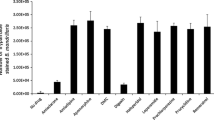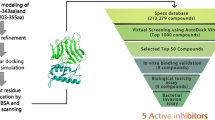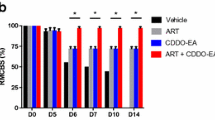Abstract
Naegleria fowleri is a free-living thermophilic flagellate amoeba that causes a rare but life-threatening infection called primary amoebic meningoencephalitis (PAM), with a very high fatality rate. Herein, the anti-amoebic potential of carboxamide derivatives possessing sulfonyl or sulfamoyl moiety was assessed against pathogenic N. fowleri using amoebicidal, cytotoxicity and cytopathogenicity assays. The results from amoebicidal experiments showed that derivatives dramatically reduced N. fowleri viability. Selected derivatives demonstrated IC50 values at lower concentrations; 1j showed IC50 at 24.65 μM, while 1k inhibited 50% amoebae growth at 23.31 μM. Compounds with significant amoebicidal effects demonstrated limited cytotoxicity against human cerebral microvascular endothelial cells. Finally, some derivatives mitigated N. fowleri-instigated host cell death. Ultimately, this study demonstrated that 1j and 1k exhibited potent anti-amoebic activity and ought to be looked at in future studies for the development of therapeutic anti-amoebic pharmaceuticals. Further investigation is required to determine the clinical relevance of our findings.





Similar content being viewed by others
Data availability
This is available upon request to the author.
References
Adalid-Peralta L, Sáenz B, Fragoso G, Cárdenas G (2018) Understanding host–parasite relationship: the immune central nervous system microenvironment and its effect on brain infections. Parasitol 145:988–999. https://doi.org/10.1017/S0031182017002189
Akbar N, El-Gamal MI, Zaraei S-O et al (2023) Anti-amoebic activity of a series of benzofuran/benzothiophene derivatives against Acanthamoeba castellanii belonging to the T4 genotype. J Appl Microbiol 134:lxac030. https://doi.org/10.1093/jambio/lxac030
Akbar N, Gul J, Siddiqui R et al (2021) Moxifloxacin and sulfamethoxazole-based nanocarriers exhibit potent antibacterial activities. Antibiotics 10:964. https://doi.org/10.3390/antibiotics10080964
Akbar N, Kaman WE, Sarink M et al (2022) Novel antiamoebic tyrocidine-derived peptide against brain-eating amoebae. ACS Omega 7:28797–28805. https://doi.org/10.1021/acsomega.2c01614
Anbar HS, Isa Z, Elounais JJ et al (2021) Steroid sulfatase inhibitors: the current landscape. Expert Opin Ther Pat 31:453–472. https://doi.org/10.1080/13543776.2021.1910237
Archibald LK, Quisling RG (2013) Central nervous system infections. In: Layon AJ, Gabrielli A, Friedman WA (eds) Textbook of neurointensive care. Springer, London, London, pp 427–517
Bellini NK, Santos TM, da Silva MTA, Thiemann OH (2018) The therapeutic strategies against Naegleria fowleri. Exp Parasitol 187:1–11. https://doi.org/10.1016/j.exppara.2018.02.010
Cárdenas-Zúñiga R, Silva-Olivares A, Villalba-Magdaleno JDA et al (2017) Amphotericin B induces apoptosis-like programmed cell death in Naegleria fowleri and Naegleria gruberi. Microbiol 163:940–949. https://doi.org/10.1099/mic.0.000500
Cope JR, Conrad DA, Cohen N et al (2016) Use of the novel therapeutic agent miltefosine for the treatment of primary amebic meningoencephalitis: report of 1 fatal and 1 surviving case: Table 1. Clin Infect Dis 62:774–776. https://doi.org/10.1093/cid/civ1021
Cope JR, Ratard RC, Hill VR et al (2015) The first association of a primary amebic meningoencephalitis death with culturable Naegleria fowleri in tap water from a US treated public drinking water system. Clin Infect Dis 60:e36–e42. https://doi.org/10.1093/cid/civ017
Debnath A, Calvet CM, Jennings G et al (2017) CYP51 is an essential drug target for the treatment of primary amoebic meningoencephalitis (PAM). PLoS Negl Trop Dis 11:e0006104. https://doi.org/10.1371/journal.pntd.0006104
Debnath A, Nelson AT, Silva-Olivares A et al (2018) In vitro efficacy of Ebselen and BAY 11-7082 against Naegleria fowleri. Front Microbiol 9:414. https://doi.org/10.3389/fmicb.2018.00414
Debnath A, Tunac JB, Galindo-Gómez S et al (2012) Corifungin, a new drug lead against Naegleria, identified from a high-throughput screen. Antimicrob Agents Chemother 56:5450–5457. https://doi.org/10.1128/AAC.00643-12
El-Gamal MI, Omar HA, Semreen MH et al (2020) Antiproliferative activity of cycloalkanecarboxamide derivatives possessing sulfonate or sulfamate moiety. Bioorganic Chem 97:103677. https://doi.org/10.1016/j.bioorg.2020.103677
El-Gamal MI, Semreen MH, Foster PA, Potter BVL (2016) Design, synthesis, and biological evaluation of new arylamide derivatives possessing sulfonate or sulfamate moieties as steroid sulfatase enzyme inhibitors. Bioorg Med Chem 24:2762–2767. https://doi.org/10.1016/j.bmc.2016.04.040
Escrig JI, Hahn HJ, Debnath A (2020) Activity of auranofin against multiple genotypes of Naegleria fowleri and its synergistic effect with amphotericin B in vitro. ACS Chem Neurosci 11:2464–2471. https://doi.org/10.1021/acschemneuro.0c00165
Giovane RA, Lavender PD (2018) Central nervous system infections. Prim Care Clin Off Pract 45:505–518. https://doi.org/10.1016/j.pop.2018.05.007
Grace E, Asbill S, Virga K (2015) Naegleria fowleri: pathogenesis, diagnosis, and treatment options. Antimicrob Agents Chemother 59:6677–6681. https://doi.org/10.1128/AAC.01293-15
Güémez A, García E (2021) Primary amoebic meningoencephalitis by Naegleria fowleri: pathogenesis and treatments. Biomolecules 11:1320. https://doi.org/10.3390/biom11091320
Hahn HJ, Abagyan R, Podust LM et al (2020) HMG-CoA reductase inhibitors as drug leads against Naegleria fowleri. ACS Chem Neurosci 11:3089–3096. https://doi.org/10.1021/acschemneuro.0c00428
Jeyamogan S, Khan NA, Anwar A et al (2018) Cytotoxic effects of benzodioxane, naphthalene diimide, porphyrin and acetamol derivatives on HeLa cells. SAGE Open Med 6:205031211878196. https://doi.org/10.1177/2050312118781962
Joseph SJ, Park S, Kelley A et al (2021) Comparative genomic and transcriptomic analysis of Naegleria fowleri clinical and environmental isolates. mSphere 6:e00637. https://doi.org/10.1128/mSphere.00637-21
Król-Turmińska K, Olender A (2017) Human infections caused by free-living amoebae. Ann Agric Environ Med 24:254–260. https://doi.org/10.5604/12321966.1233568
Laniado-Laborín R, Cabrales-Vargas MN (2009) Amphotericin B: side effects and toxicity. Rev Iberoam Micol 26:223–227. https://doi.org/10.1016/j.riam.2009.06.003
Maciver SK, Piñero JE, Lorenzo-Morales J (2020) Is Naegleria fowleri an emerging parasite? Trends Parasitol 36:19–28. https://doi.org/10.1016/j.pt.2019.10.008
Martinez AJ (1993) Free-living amebas: infection of the central nervous system. Mt Sinai J Med N Y 60:271–278
Martinez AJ, Visvesvara GS (1997) Free-living, amphizoic and opportunistic amebas. Brain Pathol 7:583–598. https://doi.org/10.1111/j.1750-3639.1997.tb01076.x
Milanes JE, Suryadi J, Abendroth J et al (2019) Enzymatic and structural characterization of the Naegleria fowleri glucokinase. Antimicrob Agents Chemother 63:e02410–e02418. https://doi.org/10.1128/AAC.02410-18
Mungroo MR, Khan NA, Maciver S, Siddiqui R (2022) Opportunistic free-living amoebal pathogens. Pathog Glob Health 116:70–84. https://doi.org/10.1080/20477724.2021.1985892
Oh Y-H, Jeong S-R, Kim J-H et al (2005) Cytopathic changes and pro-inflammatory cytokines induced by Naegleria fowleri trophozoites in rat microglial cells and protective effects of an anti-Nfa1 antibody. Parasite Immunol 27:453–459. https://doi.org/10.1111/j.1365-3024.2005.00799.x
Ong TYY, Khan NA, Siddiqui R (2017) Brain-eating amoebae: predilection sites in the brain and disease outcome. J Clin Microbiol 55:1989–1997. https://doi.org/10.1128/JCM.02300-16
Potter BVL (2018) Sulfation pathways: steroid sulphatase inhibition via aryl sulphamates: clinical progress, mechanism and future prospects. J Mol Endocrinol 61:T233–T252. https://doi.org/10.1530/JME-18-0045
Rajendran K, Anwar A, Khan NA, Siddiqui R (2017) Brain-eating amoebae: silver nanoparticle conjugation enhanced efficacy of anti-amoebic drugs against Naegleria fowleri. ACS Chem Neurosci 8:2626–2630. https://doi.org/10.1021/acschemneuro.7b00430
Rajendran K, Anwar A, Khan NA et al (2019) trans -cinnamic acid conjugated gold nanoparticles as potent therapeutics against brain-eating amoeba Naegleria fowleri. ACS Chem Neurosci 10:2692–2696. https://doi.org/10.1021/acschemneuro.9b00111
Rizo-Liendo A, Sifaoui I, Cartuche L et al (2020) Evaluation of indolocarbazoles from Streptomyces sanyensis as a novel source of therapeutic agents against the brain-eating amoeba Naegleria fowleri. Microorganisms 8:789. https://doi.org/10.3390/microorganisms8050789
Sarink MJ, Tielens AGM, Verbon A et al (2020) Inhibition of fatty acid oxidation as a new target to treat primary amoebic meningoencephalitis. Antimicrob Agents Chemother 64:e00344–e00320. https://doi.org/10.1128/AAC.00344-20
Siddiqui R, Ali IKM, Cope JR, Khan NA (2016) Biology and pathogenesis of Naegleria fowleri. Acta Trop 164:375–394. https://doi.org/10.1016/j.actatropica.2016.09.009
Siddiqui R, Rawas-Qalaji M, El-Gamal MI et al (2023) Novel anti-acanthamoebic activities of Irosustat and STX140 and their nanoformulations. Antibiotics 12:561. https://doi.org/10.3390/antibiotics12030561
Thomas MP, Potter BVL (2015) Discovery and development of the aryl O -sulfamate pharmacophore for oncology and women’s health. J Med Chem 58:7634–7658. https://doi.org/10.1021/acs.jmedchem.5b00386
Visvesvara GS (2010) Amebic meningoencephalitides and keratitis: challenges in diagnosis and treatment. Curr Opin Infect Dis 23:590–594. https://doi.org/10.1097/QCO.0b013e32833ed78b
Visvesvara GS (2013) Infections with free-living amebae. In: Handbook of clinical neurology. Elsevier, pp 153–168
Visvesvara GS, Stehr-Green JK (1990) Epidemiology of free-living ameba infections. J Protozool 37:25s–33s. https://doi.org/10.1111/j.1550-7408.1990.tb01142.x
Zhou W, Debnath A, Jennings G et al (2018) Enzymatic chokepoints and synergistic drug targets in the sterol biosynthesis pathway of Naegleria fowleri. PloS Pathog 14:e1007245. https://doi.org/10.1371/journal.ppat.1007245
Funding
The authors are grateful to University of Sharjah, Sharjah, United Arab Emirates, for financially supporting this study (grant No. 2101110153).
Author information
Authors and Affiliations
Contributions
RS and NAK conceptualized the study. MIG and SOZ prepared and provided all chemicals for testing. NA and BSA carried out all bioassays under the supervision of RS and NAK. NA analysed data under the supervision of RS and NAK. NA and RS prepared the first draft under the supervision of RS NAK and MIG. NAK and BSA revised and corrected the manuscript. All authors approved the final manuscript.
Corresponding authors
Ethics declarations
Ethics approval
Not applicable.
Consent to participate and consent for publication
Not applicable.
Competing interests
The authors declare no competing interests.
Additional information
Section Editor: Sutherland Maciver
Publisher’s Note
Springer Nature remains neutral with regard to jurisdictional claims in published maps and institutional affiliations.
Rights and permissions
Springer Nature or its licensor (e.g. a society or other partner) holds exclusive rights to this article under a publishing agreement with the author(s) or other rightsholder(s); author self-archiving of the accepted manuscript version of this article is solely governed by the terms of such publishing agreement and applicable law.
About this article
Cite this article
Akbar, N., Siddiqui, R., El-Gamal, M.I. et al. The anti-amoebic potential of carboxamide derivatives containing sulfonyl or sulfamoyl moieties against brain-eating Naegleria fowleri. Parasitol Res 122, 2539–2548 (2023). https://doi.org/10.1007/s00436-023-07953-w
Received:
Accepted:
Published:
Issue Date:
DOI: https://doi.org/10.1007/s00436-023-07953-w




